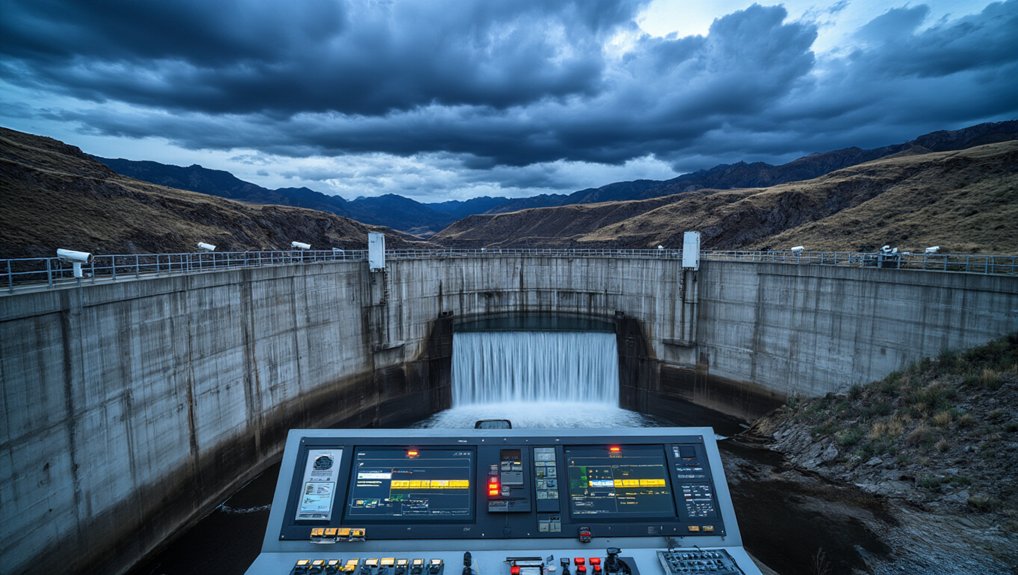Eastern Washington’s aging dams are sitting ducks for hackers. These creaky infrastructure giants control water flow for thousands downstream, and cyber criminals know it. State-sponsored hackers from Russia and China are ramping up attacks – Russia hit Ukraine 4,315 times in 2024 alone. Local cybersecurity teams scramble to patch vulnerabilities in dam control systems while Eastern Washington University churns out new defenders. The stakes? One successful breach could release catastrophic flooding.
Dam systems across the country keep getting older, and hackers keep getting smarter. That’s the nightmare scenario playing out as Eastern Washington’s aging infrastructure becomes a prime target for sophisticated cyber threats.
The numbers tell a scary story. Russian cyberattacks on Ukraine jumped nearly 70% in 2024, hitting 4,315 incidents against critical infrastructure. Chinese hackers doubled their assault on Taiwan to 2.4 million daily attempts. Think it can’t happen here? Think again.
Local cybersecurity experts are scrambling to protect dam control systems from malicious actors who see these facilities as juicy targets. The attacks aren’t just about stealing data anymore – they’re about disrupting operations that keep communities safe. One compromised control system could spell disaster for thousands downstream.
One compromised dam control system could spell disaster for thousands downstream
Eastern Washington University’s cybersecurity program is churning out defenders with real-world skills to counter these threats. They’re learning to spot everything from malware distribution to phishing campaigns, plus the sneaky insider threats that behavioral analytics might catch. AI-driven attacks? Yeah, that’s a thing now too. The university holds the prestigious designation as a National Center of Academic Excellence in Cyber Defense, making it the only four-year institution in eastern Washington with this honor.
The vulnerabilities run deep. Third-party vendors create entry points – just ask the U.S. Treasury about their recent breach. Energy sector infrastructure remains a favorite target. State-sponsored hackers even infiltrate other hacking groups to exploit their infrastructure. It’s like criminal inception, but with worse consequences.
Washington State has implemented strict data privacy laws, including the My Health My Data Act and Washington Privacy Act. Organizations face serious penalties for screwing up compliance.
Meanwhile, incident response teams are developing protocols specific to dam protection, running simulation exercises that hopefully they’ll never need in real life. Water and wastewater facilities can strengthen their defenses by attending the Regional Water Cybersecurity Workshop scheduled for June 11 and 18, 2025, which covers OT cybersecurity and business continuity planning.
Regional collaboration is ramping up through events like the 2025 Seattle Data Security Summit, where experts share knowledge about securing machine identities, mitigating AI-generated code risks, and managing expanding attack surfaces.
They’re building resilient data architectures while decoupling data for privacy. The race is on. Local experts are fortifying defenses through continuous monitoring, cloud security improvements, and cross-sector expertise combining information security, data engineering, and compliance.
Because when it comes to protecting critical infrastructure, second place means catastrophe.
References
- https://www.waswd.org/blog_home.asp?Display=14
- https://www.ewu.edu/cstem/cybersecurity/
- https://ismg.events/summit/cybersecurity-summit-seattle-datasecurity-2025/
- https://www.csis.org/programs/strategic-technologies-program/significant-cyber-incidents
- https://www.navsea.navy.mil/Home/Warfare-Centers/NSWC-Dahlgren/






